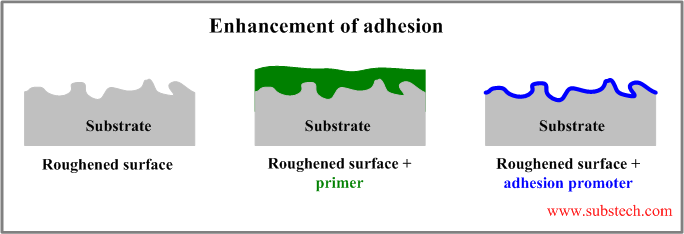Main page
About us
Sliding Bearings Consulting
Advertising Opportunities

Enhancement of adhesion
Dr. Dmitri Kopeliovich
Adhesion of a coating (paint, adhesive) to the substrate is a critical property determining its quality, durability and aesthetic properties.
Strong adhesion is achieved by a combination of the surface treatment including cleaning (degreasing), mechanical or chemical roughening and increasing the substrate wettability.
Cleaning
The first and mandatory stage of any surface preparation prior to the cating deposition is cleaning and degreasing.
At this stage the contaminants are removed from the substrate surface: mineral oils (Rust protection oils, Cutting fluids (coolants), greases, etc.), miscellaneous organic soils (paints, animal lubricants and vegetable lubricants, fingerprints).
The cleaning techniques:
- Solvent cleaning - removal of organic soils (mineral oils, fingerprints etc.) by dissolving them in a solvent. The solvent may be used in the liquid state, when the part is either immersed into the solvent or sprayed by it. The solvent may also be used in the gaseous state (vapor degreasing) when the soils are dissolved by the solvent vapors. Use of some solvents like trichloroethylene and trichlorathane (chlorinated hydrocarbons) is forbidden or restricted in most of the world due to their adverse effect on the human health.
- Alkaline cleaning – removal of organic soils (mineral oils,fingerprints, wax etc.) and some solid particles by hot alkaline solutions.
- Spray cleaning – cleaning by aqueous solutions (alkaline or mild acids) delivered to the part surface through spray nozzles at high pressure.
Surface roughening
Surface roughening improves adherence of the coating to the substrate due to the combination of the higher surface area and the anchoring effect of the microporous structure of the roughened surface.
The substrate surface may be roughened by either mechanical or chemical method.
Sand blasting, Shot peening, wire brushing, tumbling, hand sanding are used for mechanical abrading.
The main disadvantage of mechanical surface roughening is the contamination of the surface with debris and abrasive particles.
The surface should be cleaned with a dry air, clean brush or solvent after mechanical abrading.
Chemical methods of surface roughening involve microetching, conversion coatings (e.g. Black copper oxide coating), Anodizing.
to top
Primers
Primer is an intermediate layer between the substrate and the coating having a strong adhesion to the both.
Primers are used when the adherence of the coating to the substrate is weak.
Primers are commonly low viscosity liquids easily wetting the substrate surface and filling its the microscopic pores.
Primer and the topcoat (paint, adhesive, sealant) are usually made of the same polymer base.
The surface energy of a substrate coated with a primer is higher that increases the wettability and provides strong bonding of the topcoat to the substrate.
Besides enhancing adhesion primers also protect the substrate from oxidation and corrosion.
to top
Adhesion promoters
Adhesion promoter (coupling agent) is a substance, molecules of which are strongly bound (chemically absorbed) to the substrate surface in form of an ultra-thin (commonly mono-molecular) layer. The absorbed molecules are capable to interact chemically with the coating material and provide a strong adherence of the coating to the substrate.
Molecules of adhesion promoters have a chain structure with the ends differing in their chemical properties. One of the ends is an inorganic group having a chemical affinity to the substrate material whereas the second end is an organo-functional group capableto form a strong covalent bond with the organic coating (paint, adhesive).
Adhesion promoter may be either applied directly onto the substrate surface or mixed with the coating material prior to the deposition.
When it is mixed with the resin it not only promotes the adhesion to the substrate but also provides strong bonding (coupling) with the reinforcing phase.
Types of adhesion promoters:
- Organosilanes. A molecule of an organosilane contains an hydrolyzable group reacting with hydroxyl on the inorganic substrate. Molecules of organosilanes produce a polysiloxane polymer on the substrate surface. The organo-functional group reacts with the resin coating and forms a covalent bonding. The most widely used organosilane adhesion promoter is γ-glycidoxypropyltrimethoxysilane (GPTMS).
- Organotitanates. Titanates are used mainly as coupling agents for modification of the reinforcing phase surface.
- Zirconates. Zirconates act as coupling agents - similarly to titanates. The main advantage of zirconates is their stability.
- Zircoaluminates. Zircoaluminates is a cost effective replacement of organosilanes.
Plasma treatment
Plasma treatment is the physical method of enhancing adhesion of substrates via chemical modification of the surface.
Plasma treatment is used for enhansing adhesion of Polymers (e.g. polypropylene, polyethylene).
Surface energy of polymers is very low therefore their wettability and adhesion strength to coatings (paints, adhesives) are poor. Plasma treatment causes foration of oxygen containing groups on the substrate surface, which increase the surface energy and improves adhesion.
One of the plasma treatment methods is corona treatment. Corona discharge forms as a result of applying between two electrodes a high voltage potential at high frequency. The plastic part is placed within the space between the electrodes. The electrical discharge converts the surrounding air into a plasma. The plasma particles clean and oxidize the substrate surface increasing its surface energy.
The cleaning and surface modification effect of plasma treatment is not durable therefore the treated surface should be coated as fast as possible.
to top
Related internal links



